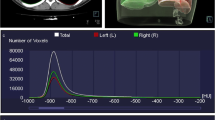Abstract
Purpose
The aim of this study was to show the difference between the pulmonary function of children with mild or severe types of pectus excavatum (PE) and post-operative changes in their predicted vital capacity (%VC) following Nuss procedure.
Patients and methods
One hundred and twenty-four of the 208 children who underwent Nuss procedure for PE between January 2007 and March 2016 were deemed eligible for this study and evaluated retrospectively. A spirometry was performed on these children on four occasions: before operation; pre-bar removal; and 1 month and 1 year after bar removal. Ninety-seven of the children who were more than 7 years of age were divided using the Haller Index (HI) into a mild group (n = 54) and a severe group (n = 43) and compared. The children were also divided into three groups based on their age and their %VC was compared at each follow-up occasion.
Results
The severe group showed a significantly lower %VC and peak expiratory flow rate than the mild group. %VC change after bar removal showed significantly lower in group aged 11 or over. 43 of the children had spirometry data recorded 1 year after bar removal which, compared with 1 month after bar removal, showed a significant higher %VC in groups aged of 10 or under.
Conclusion
Nuss procedure in children aged of 10 or under proved to be an advantage in the post-operative pulmonary function.


Similar content being viewed by others
References
Nuss D, Kelly RE Jr, Croitoru DP et al (1998) A 10-year review of a minimally invasive technique for the correction of pectus excavatum. J Pediatr Surg 33:545–552
Maagaard M, Tang M, Ringgaard S et al (2013) Normalized cardiopulmonary exercise function in patients with pectus excavatum three years after operation. Ann Thorac Surg 96:272–278
Kelly RE Jr, Shamberger RC, Mellins RB et al (2007) Prospective multicenter study of surgical correction of pectus excavatum: design, perioperative complications, pain, and baseline pulmonary function facilitated by internet-based data collection. J Am Coll Surg 205:205–216
Krasopoulos G, Goldstraw P (2011) Minimally invasive repair of pectus excavatum deformity. Eur J Cardiothorac Surg 39:149–158
Bawazir OA, Montgomery M, Harder J, Sigalet DL (2005) Midterm evaluation of cardiopulmonary effects of closed repair for pectus excavatum. J Pediatr Surg 40:863–867
Lawson ML, Mellins RB, Paulson JF et al (2011) Increasing severity of pectus excavatum is associated with reduced pulmonary function. J Pediatr 159:256–261
Lawson ML, Robert BM, Meredith T et al (2005) Impact of pectus excavatum on pulmonary function before and after repair with the Nuss procedure. J Pediatr Surg 40:174–180
Komori K, Kamagata S, Hirobe S et al (2009) Radionuclide imaging study of long-term pulmonary function after lobectomy in children with congenital cystic lung disease. J Pediatr Surg 44:2096–2100
Nonoyama A, Tanaka K, Kagawa K et al (1985) Pulmonary function after lobectomy in children under ten years of age. Nihon Kyobu Geka Gakkai Zasshi (Japanese) 33:818–824
Nuss D, Kelly RE Jr (2010) Indications and technique of Nuss procedure for pectus excavatum. Thorac Surg Clin 20:583–597
Hebra A (2009) Minimally invasive repair of pectus excavatum. Semin Thorac Cardiovasc Surg 21:76–84
Park HJ, Sung SW, Park JK et al (2012) How early can we repair pectus excavatum:the earlier the better? Eur J Cardiothirac Surg 42:667–672
Kim HK, Yoon JY, Han KN et al (2016) Effect of the Nuss procedure on the physical development of patients with pectus excavatum. Ann Thorac Cardiovasc Surg 22:327–332
Author information
Authors and Affiliations
Corresponding author
Ethics declarations
Conflict of interest
The authors declare that they have no conflict of interest.
Rights and permissions
About this article
Cite this article
Kuyama, H., Uemura, S., Yoshida, A. et al. Pulmonary function in children with Pectus excavatum and post-operative changes after nuss procedure. Pediatr Surg Int 34, 1099–1103 (2018). https://doi.org/10.1007/s00383-018-4319-0
Accepted:
Published:
Issue Date:
DOI: https://doi.org/10.1007/s00383-018-4319-0




